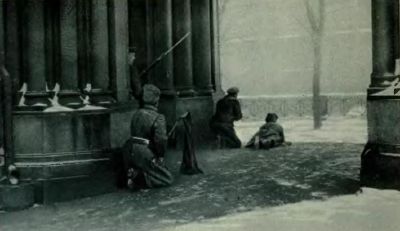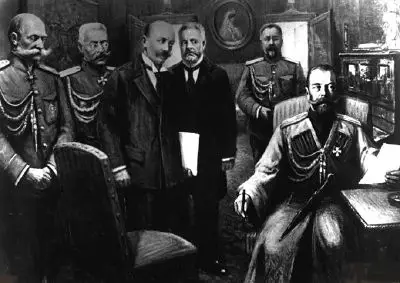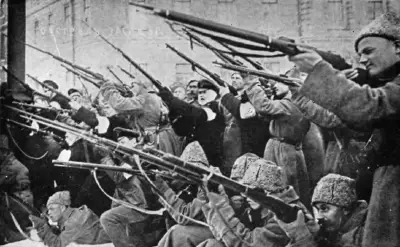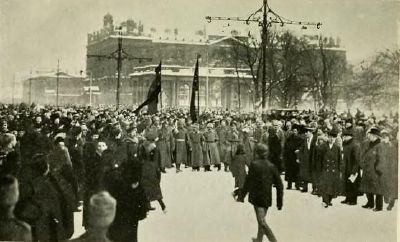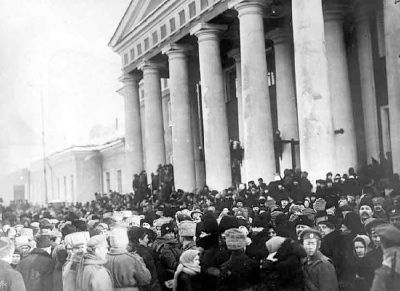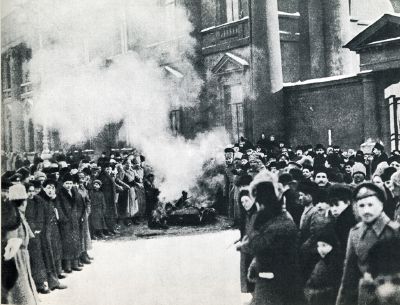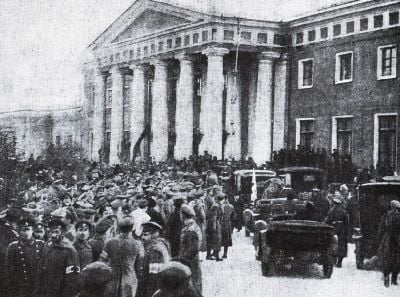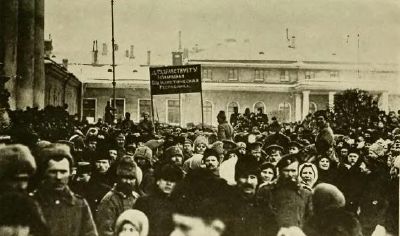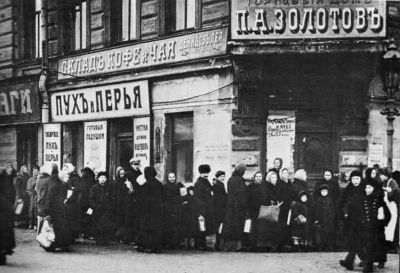February Revolution
| February Revolution | |||||||
|---|---|---|---|---|---|---|---|
| Part of the Russian Revolution, Revolutions of 1917‚Äď1923 | |||||||
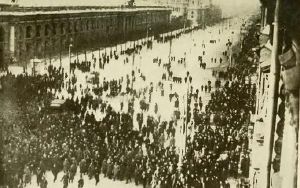 Protesters on the Nevsky Prospekt | |||||||
| |||||||
| Combatants | |||||||
Soldiers, factory workers, etc. | |||||||
| Commanders | |||||||
|
| ||||||
| Strength | |||||||
| Petrograd Police: 3,500 | |||||||
| Casualties | |||||||
| 1,443 killed in Petrograd[1] | |||||||
The February Revolution (Russian: –§–Ķ–≤—Ä–įŐĀ–Ľ—Ć—Ā–ļ–į—Ź —Ä–Ķ–≤–ĺ–Ľ—éŐĀ—Ü–ł—Ź, Fevr√°l Ļskaya revoly√ļtsiya), known in Soviet historiography as the February Bourgeois Democratic Revolution and sometimes as the March Revolution,[2] was the first of two revolutions which took place in Russia in 1917.
Russia suffered from a number of chronic economic and social problems. Reforms which had been enacted after the 1905 Revolution did not resolve those problems, which were compounded by Russia's disastrous experience in World War I. The main events of the revolution took place in and near Petrograd (present-day Saint Petersburg), the then-capital of Russia, where long-standing discontent with the monarchy erupted into mass protests against food rationing on February 23 Old Style (8 March New Style). Disaffected soldiers from the city's garrison joined bread rioters, primarily women in bread lines, and industrial strikers on the streets. As more and more troops deserted, and with loyal troops away at the Front, the city fell into chaos.
Revolutionary activity lasted about eight days, involving mass demonstrations and violent armed clashes with police and gendarmes, the last loyal forces of the Russian monarchy. On February 27 O.S. (March 12 N.S.) mutinous Russian Army forces sided with the revolutionaries. Three days later Tsar Nicholas II abdicated, ending Romanov dynastic rule and the Russian Empire. A Russian Provisional Government under Prince Georgy Lvov replaced the Council of Ministers of Russia.
Causes
Structural causes
Chief among the underlying causes of the war, Imperial Russia failed to successfully modernize its feudal social, economic and political structures throughout the nineteenth and early twentieth century. As historian Richard Pipes writes, "the incompatibility of capitalism and autocracy struck all who gave thought to the matter."[3] The old feudal relations had broken down. The aristocracy was impoverished by its obligations to the government, and its inability to adapt to a growing capitalist economy. Some reforms were instituted and a new constitution was adopted in 1906, but the autocracy was not vigorous in its implementation so the same problems that led to that revolution persisted. Peasants had been emancipated but were still tied to their communes. Their reverence for the Tsar (the Little Father) was eroded greatly after Bloody Sunday but also by the inability of most to improve their real position within the society. The growing working class wanted better working conditions and protections. Food shortage caused by Russia's war effort and a string of humiliating defeats was also a cause for dissatisfaction. The merchant class grew wealthier but wanted more political freedom and a political structure which gave them input into the rule. The spread of democracy throughout Europe gave them hope for greater democratic development.
Short-term causes
The revolution was provoked by Russian military failures during the First World War,[4] as well as public dissatisfaction with the way the country was run on the home front. The economic challenges faced due to fighting a total war exacerbated Russia's structural problems and further eroded support for the regime.
In August 1914, all classes supported [5] and virtually all political deputies voted in favor of the war.[6][7] The declaration of war was followed by a revival of nationalism across Russian society, which temporarily reduced internal strife.[8] The army achieved some early victories (such as in Galicia in 1915 and with the Brusilov Offensive in 1916) but also suffered major defeats, notably Tannenberg in August 1914, the Winter Battle in Masuria in February 1915 and the loss of Russian Poland during May to August 1915. Nearly six million casualties‚ÄĒdead, wounded and missing‚ÄĒhad been amassed by January 1917. Mutinies sprang up more often (most due to simple war-weariness), morale was at its lowest, and the newly called up officers and commanders were less trained and frequently incompetent. Russia's armed forces had inadequate supplies.[9] Prior to the revolution the desertion rate ran at around 34,000 a month.[10] Meanwhile, the wartime alliance of industry, the Duma (lower house of parliament) and Stavka (Military High Command) started to work outside the Tsar's control.[11]
In an attempt to boost morale and repair his reputation as a leader, Tsar Nicholas announced in the summer of 1915 that he would take personal command of the army, in defiance of almost universal advice to the contrary.[12] The result was disastrous on multiple fronts. Firstly, it associated the monarchy with the unpopular war; secondly, Nicholas proved to be a poor leader of men on the front, often irritating his own commanders with his interference;[13] and thirdly, working at the front made him unavailable to govern the country. This left the reins of power to his wife, the German Tsarina Alexandra, who was unpopular and accused of being a spy, and under the thumb of her confidant - Grigori Rasputin, himself so unpopular that he was assassinated by members of the nobility in December 1916.[14] The Tsarina proved an ineffective ruler in a time of war, announcing a rapid succession of different Prime Ministers and angering the Duma.[14] The lack of strong leadership is illustrated by a telegram from Octobrist politician Mikhail Rodzianko to the Tsar on February 26 O.S. (March 11 N.S) 1917, in which Rodzianko begged for a minister with the "confidence of the country" be instated immediately. Delay, he wrote, would be "tantamount to death."[15]
On the home front, a famine loomed and commodities became scarce, due to the overstretched railroad network. Meanwhile, refugees from German-occupied Russia came in the millions.[16] The Russian economy, which had just seen one of the highest growth rates in Europe, was blocked from the continent's markets by the war. Though industry did not collapse, it was considerably strained and when inflation soared, wages could not keep up.[17] The Duma, which was composed of liberal deputies, warned Tsar Nicholas of the impending danger and counseled him to form a new constitutional government, like the one he had dissolved after some short-term attempts in the aftermath of the 1905 Revolution. The Tsar ignored the advice.[13] It was predictable that "by stubbornly refusing to reach any modus vivendi with the Progressive Bloc of the Duma... Nicholas undermined the loyalty of even those closest to the throne [and] opened an unbridgeable breach between himself and the public opinion."[18] The result proved fatal as the Tsar no longer had the support of the military, the nobility or the Duma (collectively the élites), or the Russian people. The inevitable result was revolution.[19]
Events
First Steps
On 9 January 1917 [O.S. 27 December 1916] the Tsar dismissed his Prime Minister, Alexander Trepov. On 11 January 1917 [O.S. 29 December 1916] a hesitating Nikolai Golitsyn became the successor of Trepov. Golitsyn begged the Tsar to cancel his appointment, citing his lack of preparation for the role of Prime Minister. On 16 January [O.S. 3 January] 1917 Mikhail Belyaev succeeded Dmitry Shuvayev (who did not speak any foreign language) as Minister of War, likely at the request of the Tsarina.[20]
In the seventeen months of the 'Tsarina's rule', from September 1915 to February 1917, Russia had four Prime Ministers, five Ministers of the Interior, three Foreign Ministers, three War Ministers, three Ministers of Transport and four Ministers of Agriculture. This "ministerial leapfrog", as it came to be known, not only removed competent men from power, but also disorganized the work of government since no one remained long enough in office to master their responsibilities.[21]
The Duma President Mikhail Rodzianko, Grand Duchess Marie Pavlovna and British ambassador Buchanan joined calls for Alexandra to be removed from influence, but Nicholas still refused to take their advice.[22] According to Rodzianko the Tsarina "exerts an adverse influence on all appointments, including even those in the army." On 11 January O.S. (24 January N.S.) the Duma opening was postponed to the 25th (7 February N.S.).[23]
On 14 January O.S. (27 January N.S.) Georgy Lvov proposed to Grand Duke Nicholas Nikolaevich that he take control of the country. At the end of January/beginning of February major negotiations took place between the Allied powers in Petrograd; unofficially they sought to clarify the internal situation in Russia.[24]
On 14 February O.S. (27 February N.S.) police agents reported that army officers had, for the first time, mingled with the crowds demonstrating against the war and the government on Nevsky Prospekt. Alexander Kerensky took the opportunity to attack the Tsarist regime.
Protests
The revolution appeared to break out without any real leadership or formal planning.[25] By 1917, the majority of Russians had lost faith in the Tsarist regime. Thousands of workers flooded the streets of Petrograd to show their dissatisfaction. The first major protest of the February Revolution occurred on February 18 O.S. (March 3 N.S) as workers of Putilov Factory, Petrograd's largest industrial plant, announced a strike to demonstrate against the government.[26] Strikes continued on the following days. Due to heavy snowstorms, tens of thousands of freight cars were stuck on the tracks, with the bread and fuel. On February 22 O.S. (March 7 N.S.) the Tsar left for the front.[27]
On February 23 O.S. (March 8 N.S.), Putilov protesters were joined in the uprising by those celebrating International Woman's Day and protesting against the government's implemented food rationing. As the Russian government began rationing flour and bread, rumors of food shortages circulated and bread riots erupted across the city of Petrograd.[28] Women, in particular, were passionate in showing their dissatisfaction with the implemented rationing system, and the female workers marched to nearby factories to recruit over 50,000 workers for the strikes. Both men and women flooded the streets of Petrograd, demanding an end to Russian food shortages, the end of World War I and the end of autocracy."[29] By the following day February 24 O.S. (March 9 N.S), nearly 200,000 protesters filled the streets, demanding the replacement of the Tsar. The protesting mob called for the war to end and for the Russian monarchy to be overthrown.[30] By February 25 O.S (March 10 N.S), nearly all industrial enterprises in Petrograd were shut down by the uprising.[29] Although all gatherings on the streets were absolutely forbidden some 250,000 people were on strike. The president of the Imperial Duma Rodzianko asked the chairman of the Council of Ministers Nikolai Golitsyn to resign; the minister of Foreign Affairs Nikolai Pokrovsky proposed the resignation of the whole government. There were disturbances on the Nevsky Prospect during the day[31] and in the late afternoon four people were killed.
The Tsar took action to address the riots on February 25 O.S (March 10 N.S) by wiring garrison commander General Sergey Semyonovich Khabalov, an inexperienced and extremely indecisive commander of the Petrograd military district, to disperse the crowds with rifle fire[29][32] and to suppress the "impermissible" rioting by force. On February 26 O.S (March 11 N.S) the center of the city was cordoned off.
During the late afternoon of February 26 O.S (March 11 N.S) the Fourth Company of the Pavlovski Replacement Regiment broke out of their barracks upon learning that another detachment of the regiment had clashed with demonstrators near the Kazan Cathedral. After firing at mounted police the soldiers of the Fourth Company were disarmed by the Preobrazhensky Regiment. This marked the first instance of open mutiny in the Petrograd garrison.[33]
In all, over 1,300 people were killed during the protests of February 1917.[29]
Duma suspended
That evening Golitsyn used a signed, undated[34] ukaze (declaration) that his Majesty had decided to put the Duma on hiatus until April, leaving it with no legal authority to act.
On the next day (February 27 O.S, March 12 N.S), the Duma obeyed the Tsar's order, and "did not attempt to hold an official sitting." Then some delegates decided to form a Provisional Committee of the State Duma, led by Rodzianko and backed by major Moscow manufacturers and St. Petersburg bankers. Its first meeting was on the same evening and ordered the arrest of all the ex-ministers and senior officials.[35] The Duma refused to head the revolutionary movement. At the same time, socialists also formed the Petrograd Soviet. In the Mariinsky Palace the Council of Ministers of Russia, assisted by Rodzyanko, held its last meeting. Protopopov was told to resign and offered to commit suicide.[36] The Council formally submitted its resignation to the Tsar.
By nightfall, General Khabalov and his forces faced a capital controlled by revolutionaries. The protesters of Petrograd burned and sacked the premises of the district court, the headquarters of the secret police, and many police stations. They also occupied the Ministry of Transport, seized the arsenal, and released prisoners into the city.[37] Army officers retreated into hiding and many took refuge in the Admiralty building, but moved that night to the Winter Palace.[38]
Tsar's return and abdication

On 26 February O.S (11 March N.S) Mikhail Rodzianko, Chairman of the Duma, had sent the Tsar a report of the chaos in a telegram:
The situation is serious. The capital is in a state of anarchy. The Government is paralyzed. Transport service and the supply of food and fuel have become completely disrupted. General discontent is growing ... There must be no delay. Any procrastination is tantamount to death.
Rodzianko's first telegram to the Tsar, 11 March [O.S. 26 February] 1917.[39]
Nicholas's response on 27 February O.S (12 March N.S), perhaps based on the Tsarina's earlier letter to him that the concern about Petrograd was an over-reaction, was one of irritation that "again, this fat Rodzianko has written me lots of nonsense, to which I shall not even deign to reply."[40] Meanwhile, events in Petrograd continued to deteriorate. The bulk of the garrison mutinied, starting with the Volynsky Life Guards Regiment. Soldiers of this regiment brought the Litovsky, Preobrazhensky, and Moskovsky Regiments out on the street to join the rebellion,[41] resulting in the hunting down of police and the gathering of 40,000 rifles which were dispersed among the workers. Even the Cossack units that the government had come to use for crowd control showed signs that they supported the people. Although few actively joined the rioting, many officers were either shot or went into hiding; the ability of the garrison to hold back the protests was all but nullified. Symbols of the Tsarist regime were rapidly torn down around the city and governmental authority in the capital collapsed. Nicholas had earlier that day suspended a session in the Duma that was intended to discuss the issue further, leaving it with no legal authority to act. Attempts were made by high-ranking military leaders to persuade the Tsar to resign power to the Duma in an effort to collapse war efforts and establish far-left power.[13] The response of the Duma, urged on by the Progressive Bloc, was to establish a Provisional Committee to restore law and order; the Provisional Committee declared itself the governing body of the Russian Empire. Meanwhile, the socialist parties re-established the Petrograd Soviet, first created during the 1905 Revolution to represent workers and soldiers. The remaining loyal units switched allegiance the next day.[42]
On 28 February O.S (13 March N.S), at five in the morning, the Tsar left Mogilev, (and also directed Nikolay Iudovich Ivanov to go to Tsarskoe Selo) but was unable to reach Petrograd as revolutionaries controlled railway stations around the capital. Around midnight the train was stopped at Malaya Vishera, turned away, and on the evening of 1 March O.S (14 March N.S) Nicholas arrived in Pskov. In the meantime the units guarding the Alexander Palace in Tsarskoe Selo either "declared their neutrality" or left for Petrograd and thus abandoned the Imperial Family.
The Army Chief Nikolai Ruzsky, and the Duma deputies Vasily Shulgin and Alexander Guchkov who had come to advise the Tsar, suggested that he abdicate the throne. He did so on behalf of himself and his son, Tsarevich Alexei.[41] At 3 o'clock in the afternoon of Thursday, 2 March O.S (15 March N.S), Nicholas nominated his brother, the Grand Duke Michael Alexandrovich, to succeed him. The next day the Grand Duke realized that he would have little support as ruler, so he declined the crown,[41] stating that he would take it only if that was the consensus of the delegates of a yet to be elected Russian Constituent Assembly, which would be tasked with defining the form of government for Russia.[43] The 300 year-old Romanov dynasty ended with the Grand Duke's decision on 3 March O.S (16 March N.S).[44] On March 8, O.S (March 22, N.S) the former Tsar, addressed with contempt by the sentries as "Nicholas Romanov," was reunited with his family at the Alexander Palace at Tsarskoye Selo.[45] He and his family and loyal retainers were placed under protective custody by the Provisional Government in the palace.[46]
Establishment of Dual Power
The February Revolution immediately caused widespread excitement in Petrograd.[47] On 3 March O.S (16 March N.S), a provisional government was announced by the Provisional Committee of the State Duma. The Provisional Government published its manifesto declaring itself the governing body of the Russian Empire that same day. The manifesto proposed a plan of civic and political rights and the installation of a democratically elected Russian Constituent Assembly, but did not touch on many of the topics that were driving forces in the revolution such as participation in World War I and land. At the same time, the Petrograd Soviet began organizing and was officially formed on February 27. The Petrograd Soviet and the Provisional Government shared dual power over Russia. The term dual power came about as the driving forces in the fall of the monarchy, opposition to the human and widespread political movement, became politically institutionalized.[48]
While the Soviet represented the working class, the provisional government represented the merchant class and the more progressive parts of the aristocracy. The Soviet had stronger practical power because it controlled the workers and the soldiers, but it did not want to become involved in administration and bureaucracy; the Provisional Government lacked support from much of the population. Since the Provisional Government did not have the support of the majority and, in an effort to keep their claim to democratic mandate, they welcomed socialist parties to join in order to gain more support and Dvoyevlastiye (dual power) was established.[44] However, the Soviet asserted de facto supremacy as early as March 1 O.S (March 14 N.S) (before the creation of the Provisional Government), by issuing Order No. 1:
The orders of the Military Commission of the State Duma [part of the organisation which became the Provisional Government] shall be executed only in such cases as do not conflict with the orders and resolution of the Soviet of Workers' and Soldiers' Deputies.|Point 4 of Order No. 1, 1 March 1917.[49]
Order No. 1 ensured that the Dual Authority developed on the Soviet's conditions. The initial soviet executive chairmen were Menshevik Mikola Ckheidze, Matvey Skobelev and Alexander Kerensky. Following Marxist ideology, the socialist chairmen believed that the February Revolution was a "Bourgeois revolution" about bringing capitalist development to Russia instead of socialism. The center-left was well represented, and the government was initially chaired by a liberal aristocrat, Prince Georgy Yevgenyevich Lvov, a man with no connections to any official party.[50] The Provisional government included 9 Duma deputies and 6 from the Kadet party in ministerial positional, representing professional and business interests; to the Marxists they represented the bourgeoisie. As the left moved further left in Russia over the course of 1917, the Kadets became the main conservative party. Despite this, the provisional government strove to implement further left-leaning policies with the repeal of the death penalty, amnesty for political prisoners and freedom of the press.[48]
Lenin
Vladimir Lenin, exiled in neutral Switzerland, arrived in Petrograd from Z√ľrich on April 16 O.S (April 29 N.S). He immediately began to undermine the provisional government, issuing his April Theses the next month. These theses were in favor of "Revolutionary defeatism", which argues that the real enemy is those who send the proletariat into war, as opposed to the "imperialist war" (whose "link to Capital" must be demonstrated to the masses) and the "social-chauvinists" (such as Georgi Plekhanov, the grandfather of Russian socialism), who supported the war. The theses were read by Lenin to a meeting of Bolsheviks and again to a joint meeting of Bolsheviks and Mensheviks, the two major socialist parties, and was also published. He believed that the most effective way to overthrow the government was to be a minority party and to give no support to the Provisional Government.[51] Lenin also tried to take control of the Bolshevik movement and attempted to win proletariat support by the use of slogans such as "Peace, bread and land," "End the war without annexations or indemnities," "All power to the Soviet" and "All land to those who work it."[48]
Initially, Lenin and his ideas did not have widespread support, even among Bolsheviks. In what became known as the July Days, approximately half a million soldiers, sailors, and workers, some of them armed, came out onto the streets of Petrograd in protest. The protesters seized automobiles, fought with people of authority, and often fired their guns into the air. The crowd was so uncontrollable that the Soviet leadership sent the Socialist Revolutionary Victor Chernov, a widely-liked politician, to the streets to calm the crowd. The demonstrators, lacking leadership, disbanded and the government survived. Leaders of the Soviet placed the blame of the July Days on the Bolsheviks, as did the Provisional Government who issued arrest warrants for prominent Bolsheviks. Historians debated from early on whether this was a planned Bolshevik attempt to seize power or a strategy to plan a future coup.[13] Lenin fled to Finland and other members of the Bolshevik party were arrested. Lvov was replaced by the Socialist Revolutionary minister Alexander Kerensky as head of the Provisional Government.[52]
Kerensky
Kerensky declared freedom of speech, ended capital punishment, released thousands of political prisoners and tried to maintain Russian involvement in World War I. He faced many challenges related to the war. There were still very heavy military losses on the front as dissatisfied soldiers deserted in larger numbers than before. There was a strong movement in favor of withdrawing Russia from the war, which was seen to be draining the country, and many who had initially supported it now wanted out. The war had created a great shortage of food and supplies, which was very difficult to remedy. The result was great dissatisfaction with the new government on the part of the soldiers, urban workers, and peasants. Kerensky was expected to deliver on his promises of jobs, land, and food almost instantaneously, but it proved to be an impossible task.[13]
These problems were only exacerbated by the Kornilov Affair. Commander-in-Chief of the Army, General Lavr Kornilov, directed an army under Aleksandr Krymov to march toward Petrograd with Kerensky's agreement. Although the details remain sketchy, Kerensky appeared to become frightened by the possibility of a coup and the order was countermanded. On August 27 O.S (September 9 N.S), feeling betrayed by the Kerensky government, who had previously agreed with his views on how to restore order to Russia, Kornilov pushed on towards Petrograd. With few troops to spare on the front, Kerensky turned to the Petrograd Soviet for help.[53] Bolsheviks, Mensheviks and Socialist Revolutionaries confronted the army and convinced them to stand down. Conservatives felt betrayed, and the left wing was resurgent. The end of the Provisional Government would come with the disastrous experience of the Constituent Assembly.
The Constituent Assembly debacle and the October Revolution
The Constituent Assembly elections was a pledge of the Provisional Government, but organizing it proved to be a challenge. There were multiple parties involved in organizing it and little consensus on how to do it. The Bolsheviks, whose power base was urban workers, were intent on immediate elections. The Socialist-Revolutionaries (SR's), whose base was in the countryside, pushed for a delay until after the harvest. Some demonstrators pushed for female suffrage. Some were seeking a postponement until soldiers could return from the war front. Rules for the election also had to be hammered out in a country that previously had not had elections. A decision was finally reached in May for universal suffrage, proportional representation and secret ballot. Over the summer there was a number of delays and in September an election date was finally set for November 12th. The first meeting of the Assembly was set for November 28th.
By this time, pressure from the Allies to continue the war against Germany put the government under increasing strain. The conflict between the "Dual government" became obvious, and ultimately the regime and the dual power formed between the Petrograd Soviet and the Provisional Government, instigated by the February Revolution, was overthrown by the Bolsheviks in the October Revolution.[13] While candidate lists were being finalized, the Bolshevik's seized power. The election was still held, but the Assembly was first postponed and then cancelled by the Bolsheviks.
Legacy
The February Revolution will always been seen in the light of what followed. Historians disagree on the main factors. Liberal perspectives of the February revolution almost always acknowledge WWI as a catalyst to the breakdown of social institutions that resulted in revolution. "The February 1917 revolution ... grew out of pre-war political and economic instability, technological backwardness, and fundamental social divisions, coupled with gross mismanagement of the war effort, continuing military defeats, domestic economic dislocation, and outrageous scandals surrounding the monarchy."[54] Others cite the delays in creating the Constituent Assembly and the utopian nature of the liberals in wanting to make sure that everyone was included. Months of delay combined with the deterioration of conditions in the country led to more food shortages and worsening of living conditions. Liberal historians credit the Bolsheviks with the ability to capitalize on those problems.[55]
Marxists emphasize the inevitability of change.[56] Marxists and socialists see the Revolution as the "bourgeois" revolution that would necessarily come between the end of feudalism and the beginning of socialism. Soviet historians consistently place little emphasis on the role of World War I (WWI) in leading to the February Revolution. They focus more on larger structural challenges that are inherent in capitalism. Soviet historians present a narrative in which the masses that brought about revolution in February were organized groups of 'modernizing' peasants who were bringing about an era of both industrialization and freedom.[57]
Revisionists historians track the mounting pressure on the Tsarist regime back further than the other two groups to unsatisfied peasants in the countryside upset over matters of land-ownership.[58] Noted anti-communist Russian historian Richard Pipes also sees the lack of feudal institutions as key to the failure of the revolution to lead to a successful democracy. "Studying Russian history from the West European perspective, one also becomes conscious of the effect that the absence of feudalism had on Russia. Feudalism had created in the West networks of economic and political institutions that served the central state once it replaced the feudal system, as a source of social support and relative stability. Russia knew no feudalism in the traditional sense of the word, since, after the emergence of the Muscovite monarchy in the fifteenth and sixteenth centuries, all landowners were tenants-in-chief of the Crown, and subinfeudation was unknown. As a result, all power was concentrated in the Crown."[3]
Whatever the cause, the revolution failed to resolve the problems that led to the collapse of the autocracy. Those problems were not fixable in such a short time, but the failure of the Provisional Government to gain control of the situation created the opportunity which the Bolsheviks seized. The October Revolution is the ultimate legacy of the February Revolution.
Notes
- ‚ÜĎ Orlando Figes, A People's Tragedy: The Russian Revolution: 1891 - 1924 (Victoria, British Columbia: Abe Books, 2008, ISBN 9780712673273), 321.
- ‚ÜĎ The revolution occurred in March according to the Gregorian calendar, and in February according to the Julian calendar Russia was using at the time.
- ‚ÜĎ 3.0 3.1 Richard Pipes, A Concise History of the Russian Revolution (New York, New York: Knopf Press, 1996, ISBN 0679745440).
- ‚ÜĎ Sheila Fitzpatrick, The Russian Revolution (New York, NY: Oxford University Press US, ISBN 978-0198806707), 38.
- ‚ÜĎ Robert Service, A history of modern Russia from Nicholas II to Vladimir Putin (Boston, MA: Harvard University Press, 2005, ISBN 978-0674018013), 26.
- ‚ÜĎ Of 422 deputies, only 21 voted against it.
- ‚ÜĎ Ian F.W. Beckett, The Great War: 1914 - 1918, 2nd ed. (Oxfordshire, England: Routledge Press, 2007, ISBN 978-1405812528), 516.
- ‚ÜĎ Fitzpatrick, 38.
- ‚ÜĎ Beckett, 521‚Äď522.
- ‚ÜĎ Beckett, 525.
- ‚ÜĎ Beckett, 518.
- ‚ÜĎ Edward Acton, Rethinking the Russian Revolution (New York, NY: Oxford University Press US, 1990, ISBN 978-0713165302), 107‚Äď108.
- ‚ÜĎ 13.0 13.1 13.2 13.3 13.4 13.5 Mark Steinberg,The Russian Revolution, 1905 - 1921 (Oxford, England: Oxford University Press, 2017, ISBN 978-0199227624), 78-79.
- ‚ÜĎ 14.0 14.1 Fitzpatrick, 38.
- ‚ÜĎ Robert Paul Browder and Aleksandr Fyodorovich Kerensky, The Russian Provisional Government, 1917: documents (Palo Alto, CA: Stanford University Press, 1961), 40.
- ‚ÜĎ Beckett, 513.
- ‚ÜĎ Beckett, 516.
- ‚ÜĎ Acton, 107‚Äď108.
- ‚ÜĎ Fitzpatrick, 39‚Äď40.
- ‚ÜĎ A.V. Evdokimov, "–ü–ĺ—Ā–Ľ–Ķ–ī–Ĺ–ł–Ļ –≤–ĺ–Ķ–Ĺ–Ĺ—č–Ļ –ľ–ł–Ĺ–ł—Ā—ā—Ä –†–ĺ—Ā—Ā–ł–Ļ—Ā–ļ–ĺ–Ļ –ł–ľ–Ņ–Ķ—Ä–ł–ł ("The Last Minister of War of the Russian Empire,") –ö–ĺ–Ĺ–ļ—É—Ä—Ā –ľ–ĺ–Ľ–ĺ–ī—č—Ö –ł—Ā—ā–ĺ—Ä–ł–ļ–ĺ–≤ "–Ě–į—Ā–Ľ–Ķ–ī–ł–Ķ –Ņ—Ä–Ķ–ī–ļ–ĺ–≤ - –ľ–ĺ–Ľ–ĺ–ī—č–ľ," (Congress of Young Historians "Heritage of Ancestors - To the Young)". Retrieved May 20, 2022
- ‚ÜĎ Figes, 278.
- ‚ÜĎ Rosemary Crawford and Donald Crawford, Michael and Natasha: The Life and Love of Michael II, the Last of the Romanov Tsars (New York, NY: Scribner and Sons, ISBN 978-0380731916), 247‚Äď251.
- ‚ÜĎ "The Russian diary of an Englishman, Petrograd, 1915-1917". Retrieved May 20, 2022.
- ‚ÜĎ Dmitry Lyubin, "For the Faith, the Tsar and the Fatherland. The Romanovs in the First World War," in Cathelijne Broers and Mikhail Borisovich Piotrovskiń≠, 1917, Romanovs & Revolution: The End of Monarchy (Nieuwe Kerk/Hermitage: Amsterdam, 2017), 103.
- ‚ÜĎ Steinberg, 69.
- ‚ÜĎ John Shelton Curtiss, The Russian Revolutions of 1917: documents (New York, NY: Van Nostrand, 1957, ISBN 978-0442000165), 1.
- ‚ÜĎ "Letters from Tsar Nicholas to Tsaritsa Alexandra - February 1917". Retrieved May 20, 2022.
- ‚ÜĎ Beryl Williams, Russian Revolution 1917 - 1921 (Oxford, England: Oxford University Press, 1987, ISBN 9780631150831), 9.
- ‚ÜĎ 29.0 29.1 29.2 29.3 Curtiss, 30.
- ‚ÜĎ Williams, 9.
- ‚ÜĎ Simon Sebag Montefiore, The Romanovs 1613‚Äď1918, London, England: W&N, 2012, ISBN 978-0297852667), 612.
- ‚ÜĎ Harrison E. Salisbury, Black Night White Snow (Boston, MA: Da Capo Press, 1981, ISBN 978-0306801549), 372.
- ‚ÜĎ Salisbury, 349‚Äď350.
- ‚ÜĎ George Katkov, Russia, 1917: The February Revolution (Harper & Row, 1967, ISBN 978-0582126886), 286.
- ‚ÜĎ Figes, 328‚Äď329.
- ‚ÜĎ Katkov, 288.
- ‚ÜĎ Allan Wildman, "The February Revolution in the Russian Army," Soviet Studies 22 (1970): 8.
- ‚ÜĎ Katkov, 283.
- ‚ÜĎ Browder and Kerensky, 40.
- ‚ÜĎ Rex A. Wade, The Russian Revolution, 1917 (Cambridge, England, Cambridge University Press, 2017, ISBN 978-1107571259), 37.
- ‚ÜĎ 41.0 41.1 41.2 Beckett, 523.
- ‚ÜĎ Wade, 40‚Äď43.
- ‚ÜĎ Browder and Kerensky, 116.
- ‚ÜĎ 44.0 44.1 S.A. Smith, Russia in Revolution: An Empire in Crisis (1890 ‚ÄĒ 1928) (Oxford, England: Oxford University Press, 2017, ISBN 978-0198734826), 102.
- ‚ÜĎ Richard Tames, Last of the Tsars: the life and death of Nicholas and Alexandra (Clerkenwell, London: Pan Books, 1972, ISBN 978-0330029025).
- ‚ÜĎ Robert Service, The Russian Revolution (New York, NY: Macmillan Education, 1986, ISBN 978-0333388198).
- ‚ÜĎ Richard Malone, Analysing the Russian Revolution (Port Melbourne: Cambridge University Press, 2004, ISBN 978-0521541411), 92.
- ‚ÜĎ 48.0 48.1 48.2 Smith, 102-106.
- ‚ÜĎ Browder and Kerensky, 40.
- ‚ÜĎ Service 2005, 34.
- ‚ÜĎ V.I. Lenin, "April Thesis," Seventeen Moments in Soviet History, August 12, 2015. Retrieved May 20, 2022.
- ‚ÜĎ Edward Acton, V. IÔł†UÔł°. CherniÔł†aÔł°ev, and William G. Rosenberg Critical companion to the Russian Revolution, 1914-1921 (Bloomington, IN: Indiana University Press, 1997, ISBN 978-0253333339).
- ‚ÜĎ Mark D. Steinberg, Voices of Revolution¬†: 1917 (New Haven, CT: Yale University Press, 2001, ISBN 9780300101690), 161‚Äď165.
- ‚ÜĎ Alexander Rabinowitch, The Bolsheviks in Power: The First Year of Soviet Rule in Petrograd (Bloomington, IN: Indiana University Press, 2008, ISBN 978-0253220424), 1.
- ‚ÜĎ Wildman, 23.
- ‚ÜĎ Acton, 107‚Äď108.
- ‚ÜĎ Joseph Bradley, "The February Revolution," Russian Studies in History 56(1) (2017): 1‚Äď5.
- ‚ÜĎ Timothy O'Connor, "Review of Rethinking the Russian Revolution," Studies in East European Thought 47(1/2) (1995): 133‚Äď138.
ReferencesISBN links support NWE through referral fees
- Acton, Edward, Rethinking the Russian Revolution. Bloomsbury Academic, 1990. ISBN 978-0713165302
- Acton, Edward, V. IÔł†UÔł°. CherniÔł†aÔł°ev, and William G. Rosenberg. Critical Companion to the Russian Revolution, 1914-1921. Bloomington, IN: Indiana University Press, 1997. ISBN 978-0253333339
- Beckett, Ian F.W., The Great War: 1914 - 1918. Oxfordshire, England: Routledge Press, 2007. ISBN 978-1405812528
- Broers, Cathelijne, and Mikhail Borisovich Piotrovskiń≠. 1917, Romanovs & Revolution: The End of Monarchy. Hermitage, 2017.
- Browder, Robert Paul, and Aleksandr Fyodorovich Kerensky. The Russian Provisional Government, 1917: documents. Palo Alto, CA: Stanford University Press, 1961. ASIN B001W8O668
- Crawford, Rosemary, and Donald Crawford. Michael and Natasha: The Life and Love of Michael II, the Last of the Romanov Tsars. New York, NY: Scribner and Sons, 2000. ISBN 978-0380731916
- Curtiss, John Shelton, The Russian Revolutions of 1917: documents. New York, NY: Van Nostrand, 1957. ISBN 978-0442000165
- Figes, Orlando. A People's Tragedy: The Russian Revolution: 1891 - 1924. Penguin Books, 1998. ISBN 978-0140243642
- Fitzpatrick, Sheila. The Russian Revolution. New York, NY: Oxford University Press, 2017. ISBN 978-0198806707
- Katkov, George. Russia, 1917: The February Revolution. Harper & Row, 1967, ISBN 978-0582126886
- Malone, Richard, Analysing the Russian Revolution. Port Melbourne: Cambridge University Press, 2004. ISBN 978-0521541411
- Montefiore, Simon Sebag. The Romanovs 1613‚Äď1918. London, England: W&N, 2012. ISBN 978-0297852667
- Pipes, Richard, Three "whys" of the Russian Revolution. New York, NY, Vintage Books, 1997, ISBN 978-0679776468
- Pipes, Richard. A Concise History of the Russian Revolution. New York, NY: Knopf Press, 1996, ISBN 0679745440
- Rabinowitch, Alexander. The Bolsheviks in Power: The First Year of Soviet Rule in Petrograd. Bloomington, IN: Indiana University Press, 2008. ISBN 978-0253220424
- Salisbury, Harrison E. Black Night White Snow. Boston, MA: Da Capo Press, 1981. ISBN 978-0306801549
- Service, Robert. The Russian Revolution. New York, NY: Macmillan Education, 1986. ISBN 978-0333388198
- Service, Robert. A History of Modern Russia from Nicholas II to Vladimir Putin. Boston, MA: Harvard University Press, 2005. ISBN 978-0674018013
- Smith, S.A. Russia in Revolution: An Empire in Crisis (1890 ‚ÄĒ 1928). Oxford, England: Oxford University Press, 2017. ISBN 978-0198734826
- Steinberg, Mark D. Voices of Revolution: 1917. New Haven, CT: Yale University Press, 2001. ISBN 978-0300101690
- Steinberg, Mark D. The Russian Revolution, 1905-1921. Oxford University Press, 2017. ISBN 978-0199227624
- Tames, Richard. Last of the Tsars. London, England: Pan Books Ltd, 1972. ISBN 978-0330029025
- Wade, Rex A. The Russian Revolution, 1917. Cambridge, England, Cambridge University Press, 2017. ISBN 978-1107571259
- Williams, Beryl. Russian Revolution 1917 - 1921. Basil Blackwell, 1991 (original 1987). ISBN 978-0631150831
External links
All links retrieved March 25, 2024.
- Russian Revolutions 1905‚Äď1917
- Leon Trotsky's account
- –õ—é—ā–Ĺ–Ķ–≤–į —Ä–Ķ–≤–ĺ–Ľ—é—Ü—Ė—Ź. –Ė—Ė–Ĺ–ĺ—á–ł–Ļ –Ī—É–Ĺ—ā, —Ź–ļ–ł–Ļ –∑–Ĺ–ł—Č–ł–≤ –†–ĺ—Ā—Ė–Ļ—Ā—Ć–ļ—É —Ė–ľ–Ņ–Ķ—Ä—Ė—é (February Revolution. Female mutiny that destroyed the Russian Empire) Ukrayinska Pravda
Credits
New World Encyclopedia writers and editors rewrote and completed the Wikipedia article in accordance with New World Encyclopedia standards. This article abides by terms of the Creative Commons CC-by-sa 3.0 License (CC-by-sa), which may be used and disseminated with proper attribution. Credit is due under the terms of this license that can reference both the New World Encyclopedia contributors and the selfless volunteer contributors of the Wikimedia Foundation. To cite this article click here for a list of acceptable citing formats.The history of earlier contributions by wikipedians is accessible to researchers here:
The history of this article since it was imported to New World Encyclopedia:
Note: Some restrictions may apply to use of individual images which are separately licensed.
